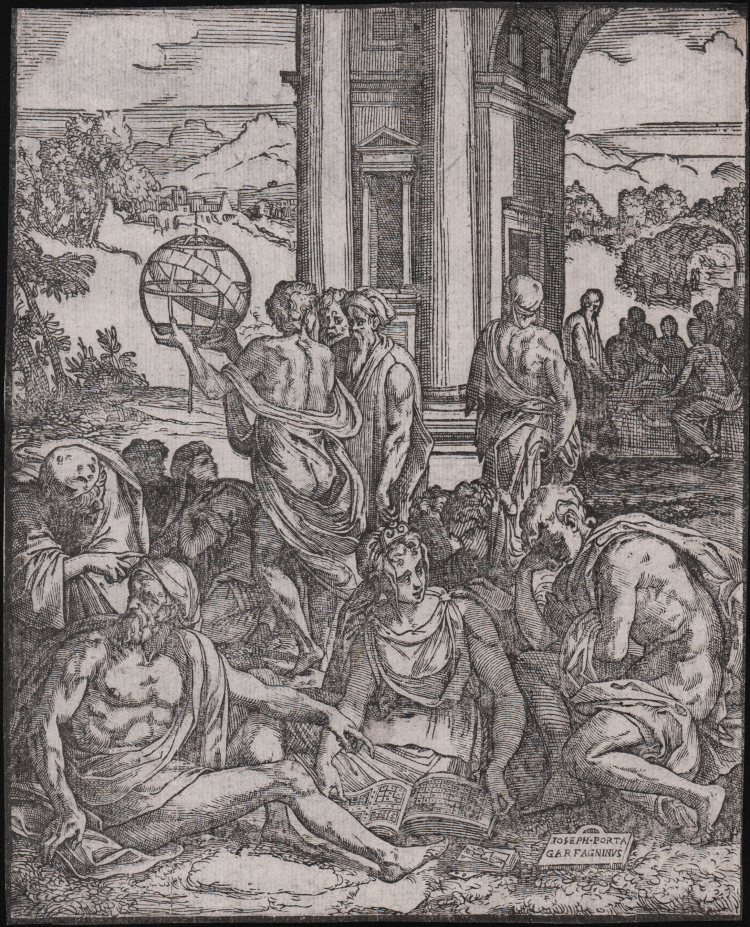- New




| Reference: | S48727 |
| Author | Giuseppe Porta SALVIATI |
| Year: | 1540 |
| Measures: | 194 x 240 mm |



| Reference: | S48727 |
| Author | Giuseppe Porta SALVIATI |
| Year: | 1540 |
| Measures: | 194 x 240 mm |
The woodcut depicts a group of men and women intent on talking with each other in the Giardino dei Pensieri: the figures in the foreground are seated on the ground in different attitudes, intent on playing the game of fortunes; four other standing figures occupy the center of the scene, three of them in groups and one of them holding an armillary sphere. In the distance below an atrium several figures, standing or seated around a table, also appear to be occupied in the same game. A tablet located on the ground in the lower right-hand corner reads: IOSEPH PORTA GARFAGNINUS.
This print constituted the frontispiece of Francesco Marcolini's work “Giardino dei Pensieri” published in 1540. This illustration constitutes the first work signed by Salviati during his collaboration with the Venetian publisher. The book, which was republished in 1550 under a different title (Le ingegnose sorti), represents the typical product of Renaissance culture: an elaborate study of foresight based on playing cards, expressed by an explanatory text in terza rima. In the print catalogued here, Giardino dei Pensieri is depicted as a kind of Arcadian school of Athens: a group of astrologers, holding the armillary sphere, discuss the fate of the universe, while other philosophers, apparently immersed in deep meditation, follow the directions of the cards while holding an open book in front of them. The elegant poses, playful hatching, and skillful modeling reveal Salviati's Roman education; the chiaroscuro richness and hints of landscape testify to Venetian influence.
“La xilografia costituisce “la prima opera firmata dal Salviati nel corso della sua collaborazione con l'editore veneziano Francesco Marcolini. Il libro, poi riedito nel 1550 con un titolo leggermente diverso (Le ingeniose sorti...), rappresenta un tipico prodotto della cultura rinascimentale: un elaborato studio di preveggenza basato sulle carte da gioco, espresso da un testo esplicativo in terza rima. Il disegno del Salviati innalza questi giuochi al livello di una speculazione filosofica e rappresenta il Giardino di Pensieri del Marcolini come una specie di arcadica "Scuola di Atene": un gruppo di astrologi, reggendo la sfera armillare, come nel Triumpho di Fortuna di Sigismondo Fanti del 1526, discute sulle sorti dell'universo, mentre altri filosofi, apparentemente immersi in una profonda meditazione, seguono le indicazioni delle carte tenendo davanti un libro aperto. Le pose eleganti e il gioco dei tratteggi rivelano l'educazione romana del Salviati, come particolarmente si vede nella sapienza con cui sono disegnate e modellate le figure. Un influsso veneziano si può notare nella ricchezza chiaroscurale e negli accenni del paesaggio vicino e lontano. Non è possibile escludere che sia stato lo stesso Francesco Marcolini a intagliare il disegno di questa silografia, mentre la varietà di stili delle molte figure che illustrano le Sorti rende logico pensare che l'editore si sia servito anche di altri intagliatori” (cfr. Tiziano e la silografia veneziana del Cinquecento, p. 145).
Woodcut, printed on contemporary laid paper with “four-leaf clover” watermark, minimal restorations to lower corners, overall in very good condition.
Bibliografia
Muraro-Rosand, Tiziano e la silografia veneziana del Cinquecento, p. 145, n. 90; Passavant, VI, p. 240, n. 89.
Giuseppe Porta SALVIATI (Castelnuovo di Garfagnana, 1520 circa - Venezia, 1575 circa).
|
Italian painter. He was apprenticed to Francesco Salviati in Rome from 1535 and apparently assisted him in the decoration of a number of façades there. The gravitas and sculptural quality of the Roman figural style are reflected in Giuseppe’s later work. In 1539, with Francesco, he left Rome, stopping in Florence and Bologna, where he met Giorgio Vasari, and arriving in Venice by 11 July. Giuseppe’s earliest known independent works are illustrations for Le sorti, a book on fortune-telling published by Francesco Marcolini (Venice, 1540).
|
Giuseppe Porta SALVIATI (Castelnuovo di Garfagnana, 1520 circa - Venezia, 1575 circa).
|
Italian painter. He was apprenticed to Francesco Salviati in Rome from 1535 and apparently assisted him in the decoration of a number of façades there. The gravitas and sculptural quality of the Roman figural style are reflected in Giuseppe’s later work. In 1539, with Francesco, he left Rome, stopping in Florence and Bologna, where he met Giorgio Vasari, and arriving in Venice by 11 July. Giuseppe’s earliest known independent works are illustrations for Le sorti, a book on fortune-telling published by Francesco Marcolini (Venice, 1540).
|